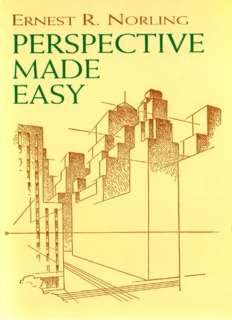‘Perspective Made Easy’ PDF Quick download link is given at the bottom of this article. You can see the PDF demo, size of the PDF, page numbers, and direct download Free PDF of ‘Perspective Made Easy’ using the download button.
Perspective Made Easy PDF Free Download

Perspective Made Easy
In a perspective drawing, all parallel lines meet at a point, no matter how many lines there are or how high they are from the ground.
On reaching the eye level, all the horizontal lines merge into the eye level line.
Parallel lines below eye level curve upward; When above eye level, they taper down towards the vanishing point.
A building can be thought of as a pile of bricks. Anyone who can make bricks can also make a city.
Stack the books on your desk so that the top edge of the top book reaches your eye level. Draw a diagram.
Now stand up and sketch the same group. Place books on something that is above eye level and sketch them.
Compare the three pictures.
Draw a picture of some buildings that you can see from your window.
Build it as if it were bricks. Now create a whole bunch of buildings like this,
Note that both points cannot be on the same side of the drawing.
As we rotate the cube to make that relation, we find that the point moves to the other side.
One perspective point is to the left of the center of interest and the other to the right.
Of course, this relationship does not hold up to a one-point approach.
When you point in the same direction as the line you’re drawing, you’re pointing to the vanishing point of that line.
The two vanishing points are located at eye level in the direction of the two lines forming the corner of the square on which you are standing.
As the object rotates this corner rotates around the point you are standing on.
This way you can follow the change in the direction of the points.
The two vanishing points lie on opposite sides of the center of interest. They can’t get together.
Now let’s look at Deepak’s smile; It rests on the floor and is required to face down.
The shade is above our eye height while the base is below.
Somewhere in the middle is eye level, a place that is exactly the same height from the floor as our eyes are.
We show this eye-level through a straight line in the diagram.
We find that we have control over this eye-level line. We can look under the table and see the underside.
We accomplish this by lowering our eye level.
We stand on tiptoes or climb on a box to look over the heads of people in a crowd, we do this to raise the eye level.
Our different ways of moving our eyes up and down create new images constantly before our eyes.
It is interesting to see the effects and changes in the landscape when viewed from an automobile driving on a mountain road.
Showmen have taken advantage of this fact and created the Ferris wheel, a mechanical means of rapidly raising and lowering eye level.
The quick change of picture helps to intensify the experience.
We find that the objects we draw fall into two classes: one above and one below the line that indicates eye level.
| Writer | Ernest Norling |
| Language | English |
| Pages | 228 |
| Pdf Size | 13 MB |
| Category | Engineering |
Perspective Made Easy Pdf Free Download
